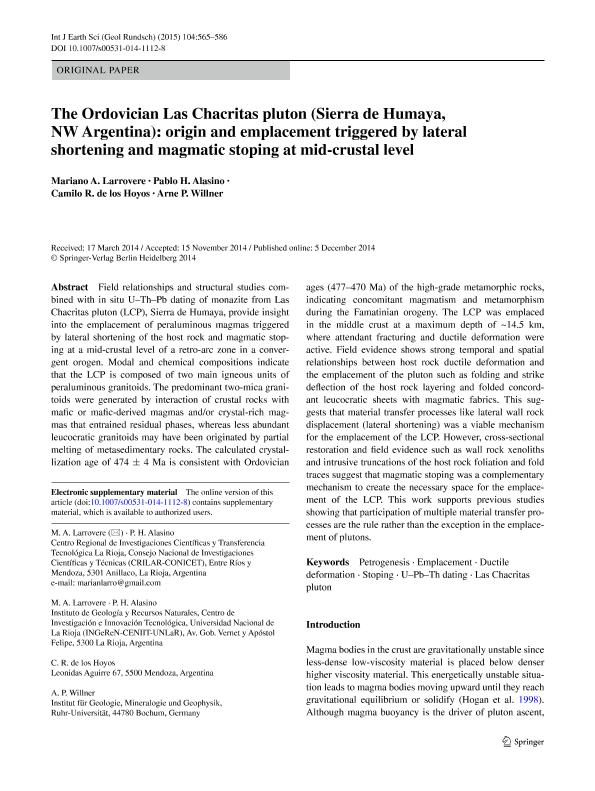Artículo
The Ordovician Las Chacritas pluton (Sierra de Humaya, NW Argentina): origin and emplacement triggered by lateral shortening and magmatic stoping at mid-crustal level
Fecha de publicación:
04/2015
Editorial:
Springer Verlag Berlín
Revista:
International Journal of Earth Sciences
ISSN:
1437-3254
Idioma:
Inglés
Tipo de recurso:
Artículo publicado
Clasificación temática:
Resumen
Field relationships and structural studies combined with in situ U-Th-Pb dating of monazite from Las Chacritas pluton (LCP), Sierra de Humaya, provide insight into the emplacement of peraluminous magmas triggered by lateral shortening of the host rock and magmatic stoping at a mid-crustal level of a retro-arc zone in a convergent orogen. Modal and chemical compositions indicate that the LCP is composed of two main igneous units of peraluminous granitoids. The predominant two-mica granitoids were generated by interaction of crustal rocks with mafic or mafic-derived magmas and/or crystal-rich magmas that entrained residual phases, whereas less abundant leucocratic granitoids may have been originated by partial melting of metasedimentary rocks. The calculated crystallization age of 474 ± 4 Ma is consistent with Ordovician ages (477-470 Ma) of the high grade metamorphic rocks, indicating concomitant magmatism and metamorphism during the Famatinian orogeny. The LCP was emplaced in the middle crust at a maximum depth of ~ 14.5 km, where attendant fracturing and ductile deformation were active. Field evidence shows strong temporal and spatial relationships between host rock ductile deformation and the emplacement of the pluton such as folding and strike deflection of the host rock layering and folded concordant leucocratic sheets with magmatic fabrics. This suggests that material transfer processes like lateral wall rock displacement (lateral shortening) was a viable mechanisms for the emplacement of the LCP. However, cross section restoration and field evidence such as wall-rock xenoliths and intrusive truncations of the host rock foliation and fold traces suggest that magmatic stoping was a complementary mechanism to create the necessary space for the emplacement of the LCP. This work supports previous studies showing that participation of multiple material transfer processes are the rule rather than the exception in the emplacement of plutons.
Archivos asociados
Licencia
Identificadores
Colecciones
Articulos(CRILAR)
Articulos de CENTRO REGIONAL DE INV. CIENTIFICAS Y TRANSFERENCIA TECNOLOGICA DE ANILLACO
Articulos de CENTRO REGIONAL DE INV. CIENTIFICAS Y TRANSFERENCIA TECNOLOGICA DE ANILLACO
Citación
Larrovere, Mariano Alexis; Alasino, Pablo Horacio; de Los Hoyos, Camilo Raul; Willner, Arne P.; The Ordovician Las Chacritas pluton (Sierra de Humaya, NW Argentina): origin and emplacement triggered by lateral shortening and magmatic stoping at mid-crustal level; Springer Verlag Berlín; International Journal of Earth Sciences; 104; 03; 4-2015; 565-586
Compartir
Altmétricas




